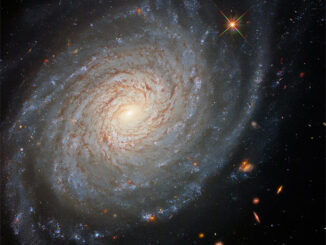
In a rare sighting, astronomers have spotted a teardrop-shaped star, the telltale sign of the distortion caused by an unseen white dwarf tugging on a small companion sun as the two spiral toward an eventual merger and a catastrophic Type 1a supernova blast.
The binary star system, known as HD265435, is located about 1,500 light years from Earth and is made up of a hot subdwarf just six-tenths as massive as the Sun and a burned out but massive white dwarf that are rotating around each other every 100 minutes.
Type 1a supernovas, which play a major role in determining the age of the universe, are thought to occur when a white dwarf’s core re-ignites in a thermonuclear explosion.
One way to trigger such a blast is for the white dwarf to suck in enough material from a companion star to reach a mass known as the Chandrasekhar limit – 1.4 times the mass of the Sun. When that happens, the white dwarf’s core is crushed to the point where it re-ignites and explodes.
Another way to trigger a Type 1a supernova is in a binary system in which the total mass of a white dwarf and a merging companion are near or above the Chandrasekhar limit. That appears to be the case with HD265435.
“We don’t know exactly how these supernovae explode, but we know it has to happen because we see it happening elsewhere in the universe,” said Ingrid Pelisoli of the University of Warwick Department of Physics and lead author of a paper in Nature.
“One way is if the white dwarf accretes enough mass from the hot subdwarf, so as the two of them are orbiting each other and getting closer, matter will start to escape the hot subdwarf and fall onto the white dwarf,” she said. “Another way is that because they are losing energy to gravitational wave emissions, they will get closer until they merge. Once the white dwarf gains enough mass from either method, it will go supernova.”
Pelisoli’s team did not directly observe the white dwarf. Instead, the researchers used data from NASA’s Transiting Exoplanet Survey Satellite, or TESS, to observe how the brightness of the subdwarf varied over time, indicating the presence of a massive nearby object that was distorting the star’s shape.
Then, using spectrographs at the Palomar and Keck observatories, the team measured the radial and rotational velocity of the subdwarf to confirm the presence of a white dwarf as heavy as the Sun but slightly smaller than Earth. Combined with the subdwarf, the system has the mass needed to eventually trigger a Type 1a supernova.
“Keck’s ESI (Echellette Spectrograph and Imager) data were crucial in determining that the compact binary system exceeds the Chandrasekhar mass limit, which makes HD265435 one of the very few supernova Ia progenitor systems known,” said co-author Thomas Kupfer, a physics professor at Texas Tech University.
Based on their observations and theoretical models, the team concludes the white dwarf will go supernova in about 70 million years.
Type 1a supernovas are used as “standard candles” by cosmologists because they seem to explode in the same way across the universe, shining with a uniform brightness. Calculating the effects of distance on that brightness, researchers can derive how far away a Type 1a supernova is. Combined with measurements of the host galaxy’s velocity, astronomers can calculate how fast the universe is expanding.
“The more we understand how supernovae work, the better we can calibrate our standard candles,” said Pelisoli. “This is very important at the moment because there’s a discrepancy between what we get from this kind of standard candle, and what we get through other methods.”



